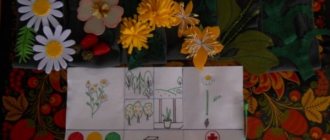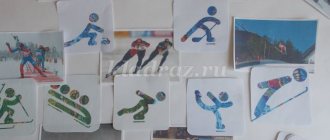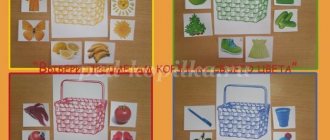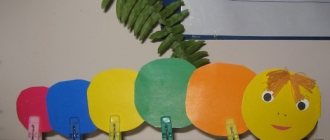Shanina Maria
Didactic games with geometric shapes for the middle group
Didactic game “Name the geometric figure ”
Target. Learn to visually examine, recognize and correctly name planar geometric shapes (circle, square, triangle, rectangle, oval)
Material. Tables with geometric shapes . Each table contains outline images of two or three figures in different positions and combinations.
Progress of the game.
The game is played with one table. The rest can be covered with a blank sheet of paper. The adult suggests carefully examining the geometric shapes , tracing the contours of the shapes , and naming them. In one lesson you can show your child 2-3 tables.
Game “Find an object of the same shape”
An adult has geometric shapes : circle, square, triangle, oval, rectangle, etc.
He shows the child one of the figures , for example, a circle. The child must name an object of the same shape.
Game "Guess what's hidden"
On the table in front of the child are cards depicting geometric shapes . The child examines them carefully. Then the child is asked to close his eyes, the adult hides one card. After the conventional sign, the child opens his eyes and says what is hidden.
Didactic game “Only one property”
Goal: to consolidate knowledge of the properties of geometric shapes , develop the ability to quickly select the desired shape , and characterize it.
Didactic manual “Find the same figure”
Didactic manual “Find the same figure”
Author: Konovalova Elena Valerievna – teacher-defectologist, TOGBU Center for Family Support and Assistance to Children “Aistenok”, Michurinsk, Tambov Region.
The manual is intended for working with preschool children with delayed development. Aimed at mastering simple sensory patterns, sorting by two characteristics - color and shape .
Helps develop classification skills. Can be used by teachers of preschool educational institutions in working with children of primary preschool age.
The manual is used at the stage of consolidating basic knowledge about color and shape. It is difficult for children with delayed development to systematize objects simultaneously according to two characteristics (color and shape, shape and size, color and size). This manual will help in this area of work and will help develop the integrity of perception and classification skills.
Target
: teaching children the skill of correlating geometric shapes based on two characteristics - color and shape.
Tasks
:
Educational
:
develop the ability to navigate two properties of objects simultaneously (color, shape), take it into account when performing a task;
consolidate ideas about color and shape;
consolidate the skills of correlating a three-dimensional form with a planar image.
Developmental
:
create conditions for the enrichment and accumulation of children’s sensory experience through object-based play activities;
develop voluntary attention, memory, thinking, analytical-synthetic processes;
develop manual motor skills and coordination of movements;
develop cognitive activity.
Educational
:
Develop the skill of self-control in the process of purposeful actions with objects (the ability not to be distracted from the task at hand, to bring the work started to completion);
To develop the ability to perform tasks by demonstration, by example, or by verbal instructions.
Equipment
: planar figures made of porous rubber (decorative foam) for creativity, “Geometric Columns” sorter.
Description of the manual
The game consists of 16 round cards depicting flat geometric shapes of different colors and shapes on each. Children must correlate a three-dimensional geometric figure with its flat image.
(0x0)
I
Option
(simple)
The child is asked to place a three-dimensional geometric figure on a card that matches the color and shape of the two offered.
(0x0)
II
Option
(difficult)
The child is asked to arrange three-dimensional geometric shapes into cards that match the color and shape.
(0x0)
III
Option
(difficult)
The child is asked to choose from these three-dimensional geometric shapes the one that matches the color and shape of the card.
(0x0)
Note
. First, it is recommended to practice correlating each geometric figure with colors (red, yellow, green, blue), and then move on to correlating based on two characteristics.
(0x0)
Progress of the game:
Those who play have a full set of geometric shapes . One places any piece . The second player must place a piece that differs from it in only one attribute. So, if the first one puts a yellow large triangle, then the second one puts, for example, a yellow large square or a blue large triangle. The game is built like a domino.
Didactic game “Find and name”
Goal: to consolidate the ability to quickly find a geometric figure of a certain size and color.
“Games with geometric shapes for children 3-5 years old”
MADOU "CRR - d/s No. 2, Shebekino, Belgorod Region"
Family advisory center:
“Games with geometric shapes for children 3-5 years old”
Prepared by:
teacher
Budnikova A.V.
A child begins to become familiar with geometric shapes at the age of 1 – 1.5 years. First, he masters the simplest shapes - circle, square, triangle. Then you need to introduce the child to more complex shapes: oval, semicircle, rectangle, rhombus, trapezoid, and so on. But acquaintance with geometric figures should not end only with the fact that the child learned their names and could, at the request of an adult, name the figure shown to him. Games with geometric shapes will help the child learn to see geometric shapes and shapes in the objects around him, to understand how shapes are formed from one another, which in turn contributes to the development of logical thinking, imagination, and attention.
But let's first figure out why you need to introduce your child to geometric shapes.
Many educational games are based on distinguishing geometric shapes: lotto, Montessori frames, Dienesha blocks, mosaics, construction sets, and so on. The sooner your baby gets acquainted with geometric figures and shapes, the wider the arsenal of educational games that you can play with him will be.
The ability to see geometric shapes in the objects around us, for example, that a ball is round and a book is rectangular, develops the child’s spatial and associative thinking and logic. The ability to see the image of an object in simple geometric figures placed next to each other, for example, that two circles of different sizes look like a chicken, and a series of triangles look like a wave, develops the imagination.
Moreover, a child who has experienced geometric figures and shapes in childhood while playing with all his senses will have a much easier time learning geometry at school.
5 rules for teaching geometric shapes:
- Point out geometric shapes to your child in everyday life. When showing a book, say that it is rectangular; when showing a saucer, give it the definition of “circle”;
- try to get feedback. Tell the child what geometric shape the sandbox, table, pillow are and ask the child to tell what he saw;
- use toys of regular geometric shapes. Play games that require knowledge of the names of the pieces.
There are a huge number of games with geometric shapes. Let's give an example of some of them:
- "Find the figure";
- "Divide the cookies";
- "Sort the shapes";
- "Lotto. Geometric figures";
- “What is gone”;
- "Associations";
- "Magic bag";
- “Arrange the figures”, etc.
Thus, knowledge of geometric shapes and their properties will broaden the child’s horizons, allow him to more accurately and comprehensively perceive the shape of surrounding objects, which will have a positive effect on productive activities (for example, drawing, modeling).
All these types of exercises will help develop spatial concepts, develop the ability to observe, analyze, generalize, highlight the main thing and at the same time cultivate such personality qualities as focus and perseverance.
-0, “find the figure”
-watch(
new wooden ones)
1, "What changed?"
2. Sorting geometric shapes
.(by color, size).
3. Divide the cookies
. Invite your child to divide the cookies (geometric shapes, first of two, then of three types) between the dolls: one is a round cookie, the other is a square one.
4, Lotto.
Lotto is a universal game; with its help you can learn anything, including geometric shapes. Geometric lotto is easy to make yourself: we make cards with shapes (3-4 shapes are enough for kids) in two copies, the second copy is cut into separate cards.
First make the shapes the same color and size. When the child has mastered the form well, you can make the figures multi-colored and of different sizes.
5, "Magic bag
" Place several geometric shapes in a small bag. Show your child a figurine of one type and ask him to find the same one in the bag. When the baby learns to relate a three-dimensional figure and its flat image (a circle and a ball, a square and a cube, a tetrahedron and a triangle, and so on), you can show him not a three-dimensional figure, but a flat image. When the baby can recognize geometric shapes in surrounding objects, it will be possible to put objects, not geometric shapes, into the bag.
6,game with geometric shapes
(lay out the figures) new!
7, “What does it look like?” (associations)
clock.table.window.ball.house, etc.
8,Applique
. By sorting the shapes, you can make appliqués. Glue circles onto a round-shaped sheet, and triangles onto a triangular-shaped sheet. For the little ones, 2-3 figures of each type are enough. Let the child choose a figure from the pile and determine which sheet to glue it on. You can cut out shapes from colored paper of different textures, cardboard, soft plastic, felt. Add a plot to the game: you make rugs for animals.
The relevance of the use of didactic games in the mathematical development of preschool children
Definition 1
Didactic games are an effective means of developing a child’s sensory abilities.
They allow us to understand the world around us, its objects and processes based on sensory perception. Children gain ideas about the shapes and sizes of objects through sensations that are activated during didactic play.
A didactic game is a productive means of cognitive development of a preschooler. Moreover, in preschool age its active development occurs. This determines the relevance of using didactic games for the development of a child’s intellectual abilities, sensory development and the formation of elementary mathematical concepts.
Are you an expert in this subject area? We invite you to become the author of the Directory Working Conditions
One of the integral components of a child’s mathematical development is the formation of ideas about geometric shapes.
A geometric figure is a set of points located on a plane in a certain sequence, forming a finite number of lines that form a limited space.
Getting acquainted with the figures, the child expands his ideas about the world around him, learns to perform various manipulations with objects, and to identify their properties.
The work of teachers is focused on introducing children to the simplest figures, their properties, and features. For these purposes, a variety of didactic games are used.
They allow:
- Consolidate theoretical material in activities;
- Activate memory and imagination;
- Develop fine motor skills of the hands, which has a positive effect on speech development;
- To develop spatial perception and orientation of a preschooler.
In didactic games, a variety of materials are used: sticks, matches, plasticine, clay, paper, from which various geometric shapes are formed. This activity promotes better memorization of figures and their properties.
Finished works on a similar topic
Course work The role of didactic games and exercises in the development of ideas about geometric shapes 440 ₽ Abstract The role of didactic games and exercises in the development of ideas about geometric shapes 220 ₽ Examination The role of didactic games and exercises in the development of ideas about geometric shapes 210 ₽
Receive completed work or specialist advice on your educational project Find out the cost
The didactic game is special in that it allows children to develop new knowledge, ideas about geometric figures, their shapes and sizes, as well as consolidate this knowledge, giving them a stable springboard.
The didactic game is exciting. This allows you to interest the child and involve him in mental activity.
The didactic game is based on a certain didactic task. Let's consider what didactic tasks form the basis of gaming activities aimed at forming preschoolers' ideas about geometric shapes.
Didactic game on geometry for children of the younger group of preschool educational institutions
Didactic game for younger preschoolers “Gifts”
Description: This game is intended to consolidate and generalize knowledge about geometric shapes in children of primary preschool age. Goal: systematization of knowledge about the completed geometric shapes (circle, square, triangle, rectangle, square, oval, heart) Objectives : - Teach children to differentiate the shapes of objects, name them correctly - Develop the ability to correlate shapes and objects similar in shape - Strengthen ideas about the basic geometric shapes, colors - Promote the development of motor skills - Expand the active and passive vocabulary of students - Strengthen the skills of counting objects (counting within 6) - Develop patience, diligence and accuracy in work Necessary materials: printouts of boxes and objects of various shapes, clothespins
This game can be used as an element of holiday classes (New Year, March 8, February 23) or various game plots (doll, bear birthday), as well as in final classes to consolidate and generalize knowledge about the geometric shapes covered. Progress of the game : Teacher: Guys, today is our doll Masha’s birthday. And you and I need to prepare gifts for her and wrap them beautifully. Look what boxes we have (We show the children boxes of different shapes one by one, explain) This box is round, this one is square, and this one is triangular. For now, the boxes are empty, and you and I need to arrange the gifts beautifully and correctly. We will put objects of the same shape in each box (we show the first picture) This is a ball. The ball is round, put it in the same box. And this is a cube. What kind of figure does it look like, which box should we put it in? (then we show pictures one at a time, ask you to name the object and its shape, try to activate adjectives in your speech - round apple, triangular pyramid, square rug)
We select the number of form boxes and pictures depending on the age and knowledge of the students. You can play both frontally (students collect gift pictures in a box of the same shape) and individually (all students have different shapes and different pictures). After all the pictures are collected, close the box with a clothespin (you can look for the same color as the box).
The ending of the game can be different - you can ask the children to remember and name which items were in the box (after the children answer, we open the boxes and check) You can count how many gifts there are in which box, compare which ones are more, which ones are smaller. Or you can play a dramatization game, for example, congratulating a friend of a friend on the New Year. We divide the students into pairs and distribute boxes of gifts. Everyone “opens” their box, saying a simple congratulation, for example, “Dear Sasha! I wish you a Happy New Year and I want to give you a balloon and a watch.” The second student thanks, opens his gift and also tells what he will give to his friend. Here are examples of some pictures, and if you are interested in this game, I will be happy to share the full archive.
We recommend watching:
Didactic games for the younger group of preschool educational institutions Didactic games for children of the 2nd junior group Didactic game for children 3-4 years old “Who eats what” Didactic games for the development of the formation of sound analysis for children 3-5 years old
Similar articles:
Didactic games with natural materials for children of primary and secondary groups in kindergarten
Didactic games in the younger group. Card index
Didactic games on the surrounding world in the second junior group
Didactic game as a means of development of children of primary preschool age
Didactic games in mathematics in the junior - middle group
Didactic tasks of familiarizing preschoolers with geometric shapes
The use of didactic games in the educational process is focused on the overall development of the child, the activation of his cognitive sphere and the development of intelligence. This is the general purpose of using didactic games. If we consider the specific area of application of didactic games, then various tasks are identified that they are aimed at solving.
Thus, the use of didactic games for the development of geometric concepts of preschoolers is focused on solving the following didactic problems:
- Formation of skills in distinguishing geometric shapes and naming them;
- Formation of skills for grouping figures according to various characteristics;
- Development of ideas about the properties of geometric shapes;
- Study of the constituent components of figures;
- Forming the skills of creating a geometric figure in different ways: drawing, designing from different materials, modeling;
- Forming the ability to identify objects in the surrounding world by attributing them to a specific geometric shape.




